Related Research Articles

Tai chi is an ancient Chinese martial art. Initially developed for combat and self-defense, it has evolved into a sport and form of exercise. Tai chi is a gentle, low-impact form of exercise in which practitioners perform a series of deliberate, flowing motions while focusing on deep, slow breaths. Often referred to as "meditation in motion," tai chi aims to concentrate and balance the body's qi, providing benefits to mental and physical health.

Chen ( ) is a common Chinese-language surname and one of the most common surnames in Asia. It is the most common surname in Taiwan (2010) and Singapore (2000). Chen is also the most common family name in Guangdong, Zhejiang, Fujian, Macau, and Hong Kong. It is the most common surname in Xiamen, the ancestral hometown of many overseas Hoklo.
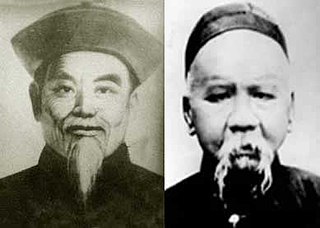
Wu (Hao)-style tai chi is one of the five primary styles of tai chi. It was created in the mid-nineteenth century by Wu Yuxiang, a member of a wealthy and influential family in Yongnian, Hebei, China. Wu trained for approximately ten years with the founder of Yang-style tai chi, and then for over a month with a Chen-style master. Wu also obtained a manual on internal martial arts that formed the core of what are now known as the tai chi classics and include Wu's own writing on the subject. From these sources Wu and his family developed their own style, and may also have developed much of the cultural and intellectual foundation of tai chi as well.
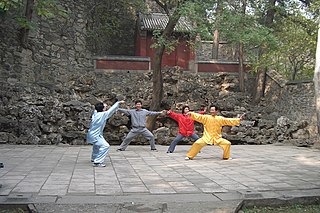
The Chen-style tai chi is a Northern Chinese martial art and the original form of tai chi. Chen-style is characterized by silk reeling, alternating fast and slow motions, and bursts of power.

Chen Fake, courtesy name Chen Fusheng (福生), was a Chinese martial artist who taught Chen-style tai chi. He was born and raised in Chen Family Village in Henan province. In 1928, Chen Fake relocated to Beijing to teach his family's heritage, Chen-style tai chi. After successfully defeating numerous challengers, Chen garnered a following of students, including several renowned martial artists. As a martial artist rather than a scholar, Chen Fake did not leave behind a written record of his accomplishments. His life story was recounted and preserved by his sons and students, most notably Hong Junsheng. By the time of his death in 1957, Chen had firmly established the global practice of Chen-style tai chi, creating a martial arts tradition that continues to thrive.

Ma Yueliang or Ma Yueh-liang was a famous Manchu teacher of tai chi. He was the senior disciple of Wu Jianquan, the founder of Wu-style tai chi, and married Wu's daughter Wu Yinghua in 1930.

Wu Yinghua (1907–1996) was a famous Chinese teacher of Wu-style tai chi. She was born in Beijing and died in Shanghai. She was the eldest daughter of Wu Jianquan, the best known teacher of Wu-style tai chi. Her older brothers were Wu Gongyi and Wu Gongzao, also well-known tai chi practitioners.
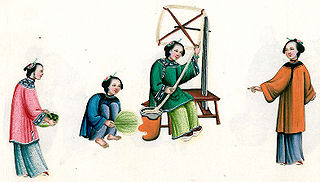
Silk reeling refers to a set of neigong movement principles expressed in traditional styles of tai chi (太極拳), but especially emphasized by the Chen and Wu styles.
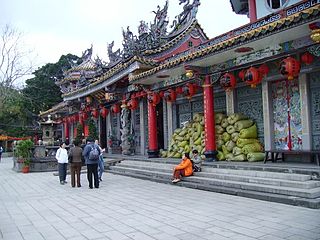
Chen Yuanguang, courtesy name Tingju, pseudonym Longhu, was a Tang dynasty general and official. He was from Gushi County, Henan. The people of Zhangzhou, Fujian, along with the descendants of immigrants from Zhangzhou to Taiwan, Singapore, Indonesia, and Malaysia, all refer to him as the "Sacred Duke, Founder of Zhangzhou".
Chen Weiming (1881–1958) was a scholar, tai chi teacher, and author. He was also known by his name Chen Zengze (陳曾則), Weiming being his hao, a pen-name.
Stephan Berwick is an American author, martial artist, and actor known for his scholarly research on traditional Chinese martial arts – particularly Chen-style taijiquan, and roles in early Yuen Wo-ping Hong Kong Action films.
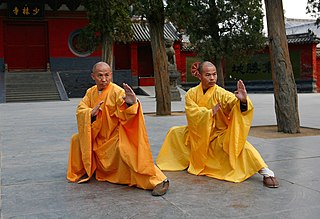
The tai chi classics are a collection of over 100 articles on the Chinese martial art of tai chi written by the art's master practitioners over the centuries. They cover everything from the underlying taiji philosophical principles, to methods of practice and application. Previously passed down in secret from generation to generation in whole or in parts through various lineages, they achieved classical status as they became public starting in the mid-1930s. Together they now serve as the single authoritative guide for the development and usage of tai chi skills. Written mostly in classical Chinese, they are used today mostly by the serious martial art practitioners of modern 6 Lineages that all trace their lineages to the ancient style taught by the Chen family and Yang family starting in the mid-19th century.

Chen Xiaowang is an Australian-Chinese tai chi teacher, who was born and raised in Chen Family Village, Wen County, Henan province, and is the 19th generation lineage holder of Chen-style tai chi. His grandfather was the Chinese martial artist and tai chi grandmaster Chen Fake.

Chen Wangting (1580–1660), courtesy name Chen Zouting, was a Ming dynasty military officer who may have founded Chen-style tai chi, one of the five major styles of the popular Chinese martial art. He reputedly devised his style of tai chi after his retirement following the fall of the Ming dynasty.

Yang Luchan, also known as Yang Fukui (1799–1872), was an influential Chinese practitioner and teacher of the internal style tai chi martial art. He is known as the founder of Yang-style tai chi, the most popular and widely practised tai chi style in the world today.

Joseph Chen Zhonghua, also known by his courtesy name Dongliang is a Chinese martial arts practitioner, teacher, and author from Shandong, China. Chen studied under two experts of the eighteenth generation of Chen-style tai chi, Hong Junsheng and Feng Zhiqiang. In 1985, Chen and his family emigrated to Canada, where he began to promote Hong's version of Chen-style tai chi to a western audience. In 2005, Chen was designated by Hong family as the International Standard-Bearer of Hong's Practical Method, during a ceremony held in Jinan. Since 2006, he has overseen a residential tai chi training program on Daqingshan in Shandong.
Hong Junsheng, born in 1907 in Henan, China, was a Chinese martial arts practitioner, teacher and author. Hong was the longest serving disciple for the Chen-style tai chi master Chen Fake. Starting in 1930, Hong trained uninterrupted with Chen for fifteen years. In 1944, Hong moved to the city of Jinan in Shandong Province. In 1956, he returned to Beijing to study again with his teacher, Chen Fake. Later, Hong expressed his understanding of Chen Fake's teachings of tai chi through his own teachings and writings. These theories and training principles are now known as the Chen-style tai chi Practical Method.
Chen Suijin is a professional wushu taolu athlete from Hong Kong specialising in taijiquan.
References
- ↑ Sim D. S.-V., e.a.: Chen Style Taijiquan: The Source of Taiji Boxing, North Atlantic Books, 2001, S. 25ff., ISBN 1-55643-377-8, hier online
- ↑ "The Chinese Contemporary Education celebrities Dictionary hardcover edition printed 1500(Chinese Edition)(Old-Used) by CHEN SHI MING: Hardcover - liu xing". Abebooks.co.uk. 2009-04-07. Retrieved 2016-03-30.
- ↑ "Chen Huixian Taijiquan Academy - 18-Form Step-by-step". Kctaiji.com. Archived from the original on 2017-05-27. Retrieved 2016-03-30.
- ↑ "Books/Videos | Grand Master Chen Zhenglei 太极宗师陈正雷". Chenzhenglei.com. 2015-07-23. Archived from the original on 2016-03-24. Retrieved 2016-03-30.
- ↑ "Chen Zhenglei". AbeBooks. Retrieved 2016-03-30.